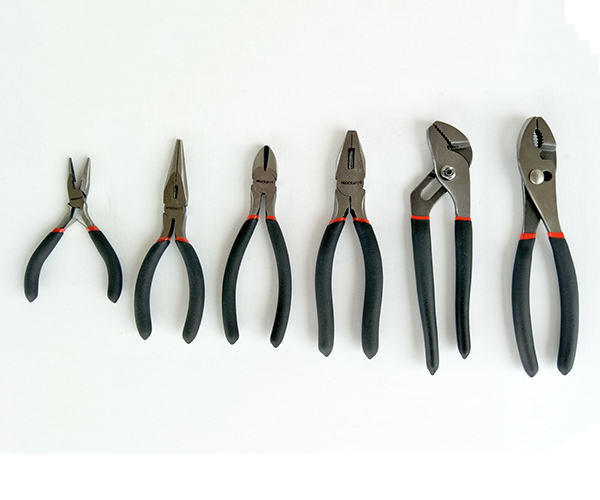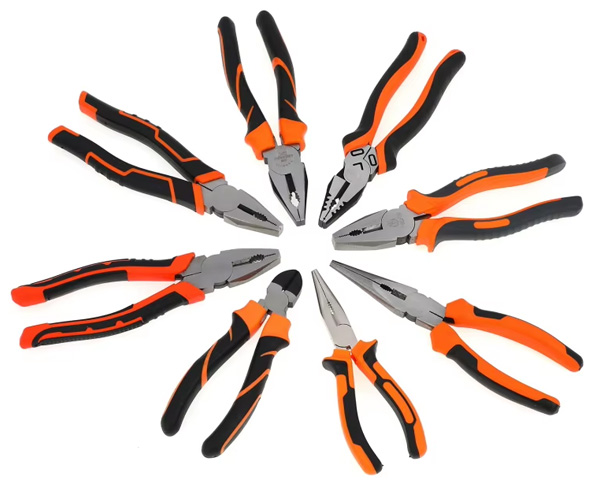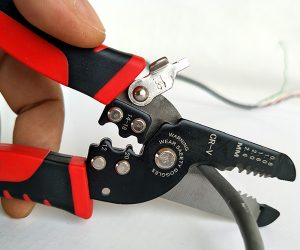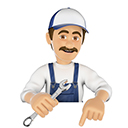In the world of hand tools, pliers play a crucial role in countless industries. Whether you’re working in construction, automotive repair, or electrical work, the reliability of your pliers can make a significant difference. So, why is it essential to choose the right pliers hand tools manufacturer? The right manufacturer ensures that you’re getting not only high-quality materials but also durable and precise tools that can withstand the rigors of everyday use. But, how do you choose a pliers hand tool manufacturer that meets your needs?
1. Why Are Pliers Important in Hand Tool Manufacturing?
Pliers are an indispensable tool in various sectors. From fixing a car to performing delicate electrical work, their versatility is unmatched. They can grip, bend, twist, and cut materials, making them essential for every professional toolkit. Ready for the good part? When crafted with precision, pliers become a seamless extension of your hand, allowing for efficient and safe work.
What makes pliers crucial in hand tool manufacturing? Well, it’s the combination of their precision and strength. The material, design, and overall construction determine the effectiveness and longevity of pliers. When manufacturers use high-quality materials, like carbon steel or chrome vanadium, it ensures the tool’s durability and resistance to wear. But here’s the kicker – the manufacturing process itself has a significant impact on the final product’s performance. Precision machining, heat treatment, and quality control all contribute to making pliers that can handle tough jobs day in and day out.
The importance of precision in pliers manufacturing can’t be overstated. Pliers are not a “one-size-fits-all” tool. The right pair of pliers is tailored to specific tasks. Whether you’re working on electrical wiring, automotive repairs, or construction projects, each type of pliers is designed to give you the best results in its respective field. With that in mind, the goal of every manufacturer is to ensure their pliers are up to the challenge.
| Feature | Description | Benefit |
|---|---|---|
| Material | Carbon Steel, Chrome Vanadium | Durability and strength |
| Precision | CNC Machining and Heat Treatment | High accuracy and effectiveness |
| Design | Ergonomic Handles | Comfort and control during use |
2. What Makes a Good Pliers Hand Tool Manufacturer?
A good pliers hand tool manufacturer isn’t just defined by their products; it’s about the values they uphold. So, what should you look for in a reliable manufacturer? First off, consistency in quality. The last thing you want is pliers that wear down after a few uses or fail under pressure. But wait, there’s more – certifications matter! Manufacturers that adhere to international standards ensure their tools meet the required performance benchmarks.
Here’s the real story: a good manufacturer will be transparent about their production processes. They’ll use state-of-the-art equipment, such as precision CNC machines, and will adhere to strict quality control measures. This ensures that each pair of pliers produced is reliable and ready for use. And of course, customer service is crucial. A responsive, knowledgeable customer support team makes the buying experience much smoother. After all, no one wants to deal with a company that doesn’t stand behind their product.
But there’s even more to consider. A good pliers manufacturer will offer customization options, allowing clients to get the exact specifications they need. Whether it’s a specific handle design or a specialized jaw shape, they’ll have the ability to create the perfect tool for the job. Ready to explore how quality and customization make a difference? Keep reading.
| Factor | Description | Why It Matters |
|---|---|---|
| Quality Control | International Standards and Testing | Ensures reliability and performance |
| Equipment | CNC Machinery and High-Tech Tools | Guarantees precision and durability |
| Customer Support | Accessible and Helpful | Enhances customer experience |
3. How Are Pliers Hand Tools Made?
So, how exactly are pliers made? This is where things get interesting. The manufacturing process of pliers involves several stages that ensure the final product is durable, precise, and functional. The first step in manufacturing pliers is selecting the right material. High-grade materials like chrome vanadium or carbon steel are preferred due to their strength, resistance to corrosion, and ability to hold sharp edges.
The next crucial step is forging the tool. During forging, the material is heated to high temperatures and shaped into the rough form of pliers. This process ensures that the pliers will be both tough and resilient. But here’s the kicker – the heat treatment process comes next. The pliers are heated and then rapidly cooled in a controlled environment to harden the steel. This gives the tool its strength while also ensuring it remains flexible enough to handle various tasks without breaking or cracking.
Finally, the pliers undergo CNC machining, where precision cutting and shaping occur to create the tool’s jaws and handles. Quality control is performed throughout the entire process to ensure each plier meets the required standards for precision and durability. By the end of the process, you have a tool that is ready to be used in the most demanding situations.
| Step | Process Description | Purpose |
|---|---|---|
| Material Selection | Chrome Vanadium or Carbon Steel | Ensures durability and resistance |
| Forging | Heating and Shaping Material | Increases toughness |
| Heat Treatment | Rapid Cooling and Heating | Enhances strength and flexibility |
4. What Are the Different Types of Pliers Manufactured?
Pliers come in various types, each designed for a specific purpose. But what’s the real story? Not all pliers are made the same. Some are designed to grip, some to cut, and others to bend. Ready to dive in? Here’s an overview of the most common types of pliers and their applications.
Needle-nose pliers are some of the most versatile tools around. With their long, slender jaws, they’re perfect for reaching tight spaces. Whether you’re working on delicate electronics or need to bend a wire in a hard-to-reach place, these pliers get the job done. On the other hand, cutting pliers, like diagonal cutters, are designed to cut through wire and cables with ease. They’re often used in electrical work or when you need to trim small objects.
But here’s the kicker – locking pliers are designed to lock into place, providing a firm grip on materials. These pliers are ideal for tasks where a strong, sustained grip is needed. And then there are slip-joint pliers, known for their adjustable jaws. These pliers can be used for a variety of tasks, from gripping pipes to bending metal. The versatility of pliers makes them indispensable in any professional toolkit.
| Type | Features | Application |
|---|---|---|
| Needle-Nose | Long, thin jaws | Precision work in tight spaces |
| Cutting Pliers | Sharp blades for cutting | Wire and cable cutting |
| Locking Pliers | Locks into position for a strong grip | Holding materials for extended periods |

5. How Do Pliers Manufacturers Ensure Durability and Precision?
When it comes to durability and precision, pliers manufacturers don’t leave anything to chance. Ready for the good part? It all starts with the material. The best pliers are made from high-quality materials like carbon steel, chrome vanadium, or alloy steel, all of which offer superior durability and resistance to corrosion. But it’s not just the material – the manufacturing process plays a huge role too.
Manufacturers use heat treatment to strengthen the steel and increase its longevity. This process involves heating the metal to a specific temperature and then rapidly cooling it. It makes the pliers stronger and more resilient to wear and tear. But here’s the kicker – precision machining is where the magic happens. Using advanced CNC machinery, manufacturers can craft pliers with razor-sharp jaws, perfectly aligned handles, and flawless fit. This ensures that the pliers perform their intended tasks with pinpoint accuracy.
And, of course, manufacturers don’t stop there. They test the tools under extreme conditions to ensure their reliability. Whether it’s squeezing them until they break or using them in tough environments, these tests ensure that the pliers will last for years without failing.
| Manufacturing Process | Description | Benefit |
|---|---|---|
| Heat Treatment | High temperatures followed by rapid cooling | Increases strength and resistance |
| Precision Machining | CNC machines used for shaping | Ensures accuracy and perfect fit |
| Durability Testing | Testing under extreme conditions | Ensures long-lasting performance |
6. Why Should You Choose a Reliable Pliers Manufacturer?
Choosing a reliable pliers manufacturer can make all the difference in the world. But wait, there’s more – a trusted manufacturer not only provides durable tools but also ensures you get value for your investment. So, why should you make that choice?
A reliable manufacturer ensures that every tool they produce undergoes strict quality control. They work with the best materials, implement the latest manufacturing technologies, and consistently improve their processes to provide superior tools. But here’s the kicker – you get to work with a partner who understands your needs. A reliable manufacturer won’t just sell you a product; they’ll work with you to ensure it’s customized to your specific requirements. Whether you need pliers for electrical work or specialized tools for construction, they’ll have the expertise to deliver.
Moreover, choosing a reliable manufacturer means you can count on consistent supply and after-sales support. Their reputation is built on customer satisfaction, and they’ll go the extra mile to ensure you get the right tools when you need them. Ready to get the best pliers for your needs? Make sure you choose a trusted manufacturer.
| Factor | Description | Why It Matters |
|---|---|---|
| Material Quality | High-grade materials used | Ensures long-lasting durability |
| Manufacturing Process | Use of precision technology | Guarantees accuracy and performance |
| Customer Support | Responsive and supportive service | Builds a long-term relationship |
7. What Are the Benefits of OEM Pliers Hand Tools?
OEM (Original Equipment Manufacturer) pliers hand tools provide significant benefits, particularly in customizations and quality. So, what’s the catch? It’s the level of control you gain over the final product. When you partner with an OEM pliers manufacturer, you’re not limited to standard tool designs. Instead, you can tailor the specifications to fit your needs, ensuring that the pliers are perfect for your specific application.
Here’s the real story: OEM pliers are designed and manufactured according to your exact requirements, from material choices to ergonomic designs. If you need pliers with special grips for comfort or a specific jaw shape for a unique task, an OEM manufacturer can deliver. This customization ensures that you’re not just buying generic tools that may not fit your needs perfectly. By opting for OEM pliers, you get a tool that’s made for your exact specifications.
Additionally, working with an OEM manufacturer often leads to higher-quality products. These manufacturers focus on producing tools for other brands, so they understand the need for precision and durability. As a result, they invest heavily in research, quality control, and the latest technologies. So, not only are you getting customized tools, but you’re also getting the assurance that they meet top-tier standards.
| Feature | Benefit | Why It Matters |
|---|---|---|
| Customization | Tailored designs for specific needs | Perfect fit for specific tasks |
| High-Quality Materials | Durable and reliable materials | Increases longevity and performance |
| Precision Manufacturing | CNC machines and expert craftsmanship | Ensures accuracy and durability |
8. How Can You Identify a High-Quality Pliers Manufacturer?
Identifying a high-quality pliers manufacturer requires careful evaluation of several factors. But here’s the kicker – not all manufacturers are created equal, so you need to dig deeper to separate the best from the rest. So, how do you find the right one? It starts with looking at the materials used in their pliers production. Quality manufacturers choose only the best materials for their tools, such as carbon steel, which offers superior strength and resistance to wear.
But wait, there’s more – a reputable manufacturer will also have certifications that attest to the quality of their products. These certifications often come from recognized industry bodies that ensure the manufacturer complies with safety and performance standards. For instance, ISO certifications indicate that the manufacturer follows rigorous quality control processes.
What else should you look for? Customer reviews and feedback. A manufacturer with a long history of producing high-quality pliers will have a solid reputation, reflected in positive customer feedback. Additionally, a good manufacturer will stand behind their products with warranties or return policies that protect your investment.
| Factor | Description | Why It Matters |
|---|---|---|
| Material Selection | High-grade steel, alloy materials | Ensures durability and performance |
| Certifications | ISO, CE, and other recognized standards | Guarantees product quality |
| Customer Feedback | Reviews, ratings, and testimonials | Reflects product reliability and trust |
9. What Are the Most Popular Pliers Brands Worldwide?
The world of pliers manufacturers is full of notable brands, but what sets these top names apart? Let’s break it down. Ready for the good part? The best pliers brands are known not only for their high-quality tools but also for their dedication to constant improvement and innovation.
Among the most well-known brands is Knipex, a German manufacturer renowned for its precision and durability. Knipex pliers are known to be some of the best in the market, often favored by professionals who need reliable, long-lasting tools. Another giant is Klein Tools, which has built a solid reputation for producing pliers that stand up to tough jobs, especially in the electrical and construction sectors.
What’s the real story? Top brands often invest heavily in R\&D to improve the functionality, ergonomics, and material choices of their pliers. For instance, Knipex uses special alloy steels and cutting-edge manufacturing techniques to ensure their pliers are tough yet precise. On the other hand, Klein Tools’ pliers are engineered for comfort, allowing users to work longer without strain. So, if you want the best of both worlds—durability and comfort—these brands are worth considering.
| Brand | Key Strengths | Common Applications |
|---|---|---|
| Knipex | Precision, durability, and innovation | General purpose, automotive, electrical |
| Klein Tools | Comfort, ergonomic design, and strength | Electrical, construction, industrial |
| ChannelLock | Strength, grip, and value | Plumbing, automotive, general use |

10. How Do Pliers Hand Tools Compare to Other Hand Tools?
Pliers may be just one tool in a toolbox, but they hold their own against other hand tools. So, what’s the difference between pliers and other essential hand tools like wrenches or screwdrivers? Pliers are unique because they are specifically designed to grip, twist, bend, or cut materials, unlike other tools that have a singular purpose.
What makes pliers stand out? It’s their versatility. Pliers can replace several other hand tools in some cases. For instance, while wrenches are excellent for turning bolts, pliers can be used for gripping and twisting, giving them an edge in certain tasks. On top of that, pliers come in numerous types, such as needle-nose pliers for precise work and locking pliers for hands-free use.
What’s the real story? The ability to perform multiple functions with just one tool makes pliers an invaluable asset. They are often used for tasks where precision, versatility, and power are needed all at once. Unlike screwdrivers, which are mostly used for driving screws, pliers are used in a much broader range of applications. So, when comparing pliers to other tools, it’s clear that their versatility gives them an edge in many scenarios.
| Tool | Purpose | Key Advantage |
|---|---|---|
| Pliers | Grip, twist, bend, or cut materials | Versatility and multiple applications |
| Wrench | Tighten or loosen fasteners | High torque for fastening |
| Screwdriver | Drive screws | Precise, controlled screw insertion |
11. What Are the Challenges in Pliers Hand Tool Manufacturing?
While manufacturing pliers may seem straightforward, it’s anything but simple. The challenges involved in making pliers go beyond simply picking the right material. So, what are the real struggles that manufacturers face? For one, there’s the challenge of ensuring that each plier is perfectly aligned and free of defects. This requires precise manufacturing processes, such as CNC machining, to ensure the jaws align correctly and the handles are ergonomically designed.
But wait, there’s more – achieving the perfect balance between strength and flexibility is another hurdle. Pliers need to be strong enough to handle tough tasks but flexible enough to be comfortable to use. This is a fine line to walk, and manufacturers invest significant time and resources to achieve the right balance.
Additionally, keeping costs down while maintaining quality is another challenge. The price of raw materials fluctuates, and manufacturers must find ways to keep costs under control without sacrificing the quality of their products. It’s a delicate balance between efficiency, quality, and pricing.
| Challenge | Description | Impact |
|---|---|---|
| Precision Alignment | Ensuring perfect jaw and handle alignment | Affects performance and comfort |
| Material Balance | Balancing strength and flexibility | Impacts durability and ease of use |
| Cost Control | Managing material costs and production | Affects pricing and profitability |
12. How Can Pliers Be Used in Various Industries?
Pliers are a staple in many industries. From electrical work to automotive repairs, their versatility makes them indispensable. Ready for the good part? In the electrical industry, needle-nose pliers are a go-to tool for precision tasks like bending wires and stripping insulation. But wait, there’s more – in construction, slip-joint pliers are used for gripping and twisting, making them ideal for pipe work.
What’s the real story? Pliers are everywhere, performing different tasks based on the needs of each industry. In automotive repair, locking pliers are often used to hold parts in place while other tasks are being completed. In plumbing, water pump pliers are used to grip and twist pipes, making repairs and installations much easier.
The versatility of pliers extends even further into niche industries. For example, jewelers use fine-tipped pliers for delicate tasks such as bending wire, and metalworkers use heavy-duty pliers for cutting and shaping metal. The wide range of applications makes pliers a must-have in almost every industry.
| Industry | Common Pliers Used | Application |
|---|---|---|
| Electrical | Needle-Nose Pliers | Bending and stripping wire |
| Automotive | Locking Pliers | Holding parts in place for repairs |
| Plumbing | Water Pump Pliers | Gripping and twisting pipes |
13. What Are the Future Trends in Pliers Hand Tool Manufacturing?
The future of pliers hand tools is evolving rapidly, with technology playing a central role. But here’s the kicker – manufacturers are increasingly adopting automation and robotic systems to streamline the production process. This not only increases efficiency but also enhances precision in the manufacturing process.
What’s the real story? Innovation doesn’t stop at automation. There are also significant advancements in material science, with manufacturers exploring new, lighter, and more durable materials for pliers. This means pliers will continue to become stronger, more ergonomic, and capable of performing more specialized tasks.
Sustainability is also making its way into the pliers manufacturing process. Many manufacturers are focusing on using recycled materials and eco-friendly production techniques. This trend is expected to grow as environmental concerns become more prominent in the industrial sector.
| Trend | Description | Potential Impact |
|---|---|---|
| Automation | Use of robotics for efficient production | Increases precision and lowers costs |
| Advanced Materials | Development of lightweight, durable materials | Improves tool strength and reduces weight |
| Sustainability | Use of eco-friendly production methods | Reduces environmental impact |
14. How to Properly Maintain Pliers for Longevity?
Taking care of your pliers ensures they last longer and perform at their best. Ready for the good part? Proper maintenance starts with cleaning. After each use, wipe down your pliers to remove dirt, debris, and grease. This helps prevent rust from forming and keeps the tool in working order. But here’s the kicker – proper storage is also essential. Always store pliers in a dry place to avoid exposure to moisture, which can cause rust.
What’s the real story? Regularly inspecting your pliers for damage is crucial. Check the jaws for wear and tear, and ensure that the handles are free from cracks. If the pliers start to feel loose or misaligned, it’s best to replace them before they fail. For cutting pliers, sharpen the edges periodically to maintain their cutting performance.
Finally, lubricate the pivot points of the pliers to ensure smooth operation. Regular lubrication prevents the moving parts from becoming stiff and ensures they open and close easily. So, with proper care, your pliers will continue to perform reliably for years to come.
| Maintenance Task | Description | Benefit |
|---|---|---|
| Cleaning | Wipe down pliers after use | Prevents rust and keeps tools clean |
| Storage | Store in a dry place | Avoids moisture exposure and rust |
| Inspection | Check for wear and tear | Identifies potential issues early |
15. Why Are Precision and Durability Essential for Pliers Hand Tools?
Precision and durability are the backbone of pliers hand tools. But here’s the kicker – when pliers are precisely engineered, they provide better control and safety during use. Precision ensures that the jaws align correctly, giving you a firm grip on materials. When used in delicate tasks, like wiring or automotive repair, this precision is essential for accurate and safe results.
What’s the real story? Durability goes hand in hand with precision. Pliers that are durable last longer, maintain their sharpness, and resist wear and tear. This ensures they can handle tough jobs over an extended period, without losing effectiveness. So, when you choose high-quality pliers, you’re investing in a tool that will consistently perform at its best.
| Feature | Description | Importance |
|---|---|---|
| Precision | High accuracy in jaw alignment | Ensures safety and control |
| Durability | Resistance to wear and tear | Provides long-lasting performance |
| Grip | Strong, reliable grip on materials | Ensures efficiency in tough tasks |
FAQ Section
Q1: What is a pliers hand tool?
Pliers are a versatile hand tool used to grip, bend, or cut materials. They come in different shapes and sizes, designed for specific tasks in various industries like automotive repair, construction, and electrical work.
Q2: How does a pliers manufacturer ensure precision in their products?
Manufacturers use advanced techniques such as CNC machining, strict quality control processes, and detailed testing to ensure that each pair of pliers meets the required precision standards.
Q3: Why should I choose a high-quality pliers manufacturer?
Choosing a high-quality manufacturer guarantees that the pliers are durable, reliable, and capable of performing intricate tasks with precision, saving you time and money in the long run.
Q4: What types of pliers are commonly used in construction?
Construction workers commonly use cutting pliers, needle nose pliers, and slip-joint pliers to handle a variety of tasks such as wire cutting, bending, and gripping objects in tight spaces.
Q5: How do I know if a pliers manufacturer is reliable?
A reliable pliers manufacturer will have positive customer feedback, industry certifications, and a track record of producing high-quality, durable tools.





